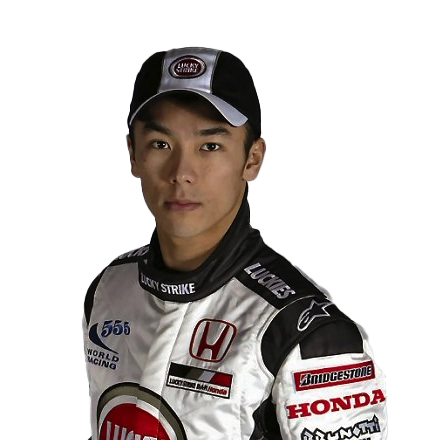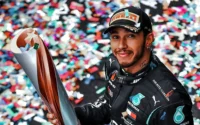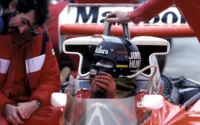Takuma Sato is a Japanese racing driver who raced in Formula One from 2002 to 2008 before moving to America, where he became a two-time Indianapolis 500 winner (2017, 2020), the only Asian driver in history to achieve that feat.
| Nationality | Japanese |
|---|---|
| Born | Takuma “Taku” Sato 28 January 1977 Shinjuku, Tokyo, Japan |
Born and raised in Tokyo, Sato started in karting before Honda backed his move to Europe in 1999. He jumped straight into Formula Three, finishing third in the 2000 British Championship and then dominating in 2001 with Carlin, winning both the Masters of Formula 3 and the 2001 Macau Grand Prix. That success paved his way to Formula One with a Honda-powered Jordan in 2002.
Formula One Career
Jordan: 2002
Sato made his F1 debut at the 2002 Australian Grand Prix alongside Giancarlo Fisichella. His season had flashes of speed but was also tainted by incidents, the most frightening came in Austria, where he was hit hard by Nick Heidfeld in a Sauber, the impact tearing open the side of his cockpit. Despite the ups and downs, Sato ended the year on a high with a strong fifth place at his home race in Suzuka.
BAR-Honda: 2003–2005
With Honda moving to British American Racing, Sato joined BAR as a test driver in 2003. At the final round in Japan he stepped in for Jacques Villeneuve, battled with Michael Schumacher, and finished sixth — enough to earn a full-time seat for 2004.
That year was Sato’s peak in Formula One. He qualified in the top three four times, even starting on the front row at the 2004 European Grand Prix, where he set a lap record. At the 2004 United States Grand Prix, he delivered a bold drive full of trademark aggression to take third place, his only F1 podium and the first for a Japanese driver since Aguri Suzuki in 1990. Despite six retirements due to reliability issues, Sato scored points in nine of 11 completed races, finishing eighth in the 2004 World Drivers’ Championship with 34 points — the best-ever season for a Japanese F1 driver. His efforts helped BAR-Honda finish second in the 2004 Constructors’ standings.
In 2005, BAR’s form slipped. Sato missed the 2005 Malaysian Grand Prix due to illness, and later the team was banned for two races after both cars were disqualified in San Marino for running underweight (a technicality later judged not deliberate). Sato’s season never really recovered — his only points came from eighth in Hungary — and Honda did not retain him when they took full control of the team for 2006.
Super Aguri: 2006–2008
Sato found a lifeline at Super Aguri, a new Honda-backed team led by Aguri Suzuki. The first half of 2006 was spent racing with a modified 2002 Arrows chassis, but Sato’s attitude and fighting spirit earned him respect. By season’s end, in the updated SA06, he was regularly beating the Midland cars and signed off with 10th place in Brazil, ahead of both Toro Rossos and the Spykers.
The breakthrough came in 2007 with the SA07, a reworked version of Honda’s 2006 car. Sato dragged it into Q3 at the season opener in Melbourne and soon after scored the team’s first points with 8th in Spain. At the 2007 Canadian Grand Prix, he produced one of the most memorable drives of his career: climbing from mid-grid to finish 6th, overtaking Ralf Schumacher and — to huge cheers — Fernando Alonso’s McLaren late in the race. The move on Alonso was voted “Overtake of the Year” by F1 Racing magazine.
By 2008, financial trouble gripped Super Aguri. The team scraped its way to the 2008 Australian Grand Prix with a hastily modified Honda RA107 and struggled with reliability. After four races, with a best result of 13th in Spain, the team withdrew from Formula One entirely.
Sato tested for Toro Rosso later that year, competing with Sébastien Bourdais and Sébastien Buemi for a 2009 race seat. He showed pace — fastest on one test day and second-fastest on another — but the seat ultimately went to Bourdais, and Sato was left without a Formula One drive.
Beyond Formula One
After Super Aguri folded in 2008, Sato spent a year out of racing before making the switch to America. He joined the IndyCar Series in 2010 with KV Racing and quickly became known for his fearless, all-or-nothing driving style.
- 2011 – Claimed his first IndyCar pole position at Iowa.
- 2013 – Made history by becoming the first Asian driver to win an IndyCar race, taking victory at the Grand Prix of Long Beach with A.J. Foyt Enterprises.
- 2014 – Entered Formula E for the opening round in Beijing, his only professional race without Honda power, driving a McLaren-powered car.
- 2017 – Achieved his greatest success by winning the Indianapolis 500 with Andretti Autosport, the first Asian driver to do so.
- 2018–2019 – Continued to win races with Rahal Letterman Lanigan Racing, cementing himself as a front-runner on both ovals and road courses.
- 2020 – Won the Indianapolis 500 for a second time, again with RLL, joining an elite group of multi-time winners.
- 2022 – Drove for Dale Coyne Racing, maintaining his reputation as a dangerous contender at Indy.
- 2023 onwards – Transitioned into part-time racing roles, focusing primarily on the Indianapolis 500 with RLL.
Takuma Sato Formula One World Championship career
| Active years | 2002–2008 |
|---|---|
| Teams | Jordan, BAR, Super Aguri |
| Entries | 92 (90 starts) |
| Championships | 0 |
| Wins | 0 |
| Podiums | 1 |
| Career points | 44 |
| Pole positions | 0 |
| Fastest laps | 0 |
| First entry | 2002 Australian Grand Prix |
| Last entry | 2008 Spanish Grand Prix |
Takuma Sato Teammates
| 6 drivers | Involvement | First Year | Last Year |
|---|---|---|---|
| Giancarlo Fisichella | 17 | 2002 | |
| Jenson Button | 38 | 2003 | 2005 |
| Anthony Davidson | 41 | 2004 | 2008 |
| Yuji Ide | 4 | 2006 | |
| Franck Montagny | 12 | 2006 | |
| Sakon Yamamoto | 11 | 2006 |
Takuma Sato Complete Formula One Results
| Year | Entrant | Chassis | Engine | 1 | 2 | 3 | 4 | 5 | 6 | 7 | 8 | 9 | 10 | 11 | 12 | 13 | 14 | 15 | 16 | 17 | 18 | 19 | WDC | Points |
|---|---|---|---|---|---|---|---|---|---|---|---|---|---|---|---|---|---|---|---|---|---|---|---|---|
| 2002 | DHL Jordan Honda | Jordan EJ12 | Honda RA002E 3.0 V10 | AUS Ret | MAL 9 | BRA 9 | SMR Ret | ESP Ret | AUT Ret | MON Ret | CAN 10 | EUR 16 | GBR Ret | FRA Ret | GER 8 | HUN 10 | BEL 11 | ITA 12 | USA 11 | JPN 5 | 15th | 2 | ||
| 2003 | Lucky Strike BAR Honda | BAR 005 | Honda RA003E 3.0 V10 | AUS | MAL | BRA | SMR | ESP | AUT | MON | CAN | EUR | FRA | GBR | GER | HUN | ITA | USA | JPN 6 | 18th | 3 | |||
| 2004 | Lucky Strike BAR Honda | BAR 006 | Honda RA004E 3.0 V10 | AUS 9 | MAL 15 † | BHR 5 | SMR 16 † | ESP 5 | MON Ret | EUR Ret | CAN Ret | USA 3 | FRA Ret | GBR 11 | GER 8 | HUN 6 | BEL Ret | ITA 4 | CHN 6 | JPN 4 | BRA 6 | 8th | 34 | |
| 2005 | Lucky Strike BAR Honda | BAR 007 | Honda RA005E 3.0 V10 | AUS 14 | MAL PO | BHR Ret | SMR DSQ | ESP | MON | EUR 12 | CAN Ret | USA DNS | FRA 11 | GBR 16 | GER 12 | HUN 8 | TUR 9 | ITA 16 | BEL Ret | BRA 10 | JPN DSQ | CHN Ret | 23rd | 1 |
| 2006 | Super Aguri F1 Team | Super Aguri SA05 | Honda RA806E 2.4 V8 | BHR 18 | MAL 14 | AUS 12 | SMR Ret | EUR Ret | ESP 17 | MON Ret | GBR 17 | CAN 15 † | USA Ret | FRA Ret | 23rd | 0 | ||||||||
| Super Aguri SA06 | Honda RA806E 2.4 V8 | GER Ret | HUN 13 | TUR NC | ITA 16 | CHN DSQ | JPN 15 | BRA 10 | ||||||||||||||||
| 2007 | Super Aguri F1 Team | Super Aguri SA07 | Honda RA807E 2.4 V8 | AUS 12 | MAL 13 | BHR Ret | ESP 8 | MON 17 | CAN 6 | USA Ret | FRA 16 | GBR 14 | EUR Ret | HUN 15 | TUR 18 | ITA 16 | BEL 15 | JPN 15 † | CHN 14 | BRA 12 | 17th | 4 | ||
| 2008 | Super Aguri F1 Team | Super Aguri SA08 | Honda RA808E 2.4 V8 | AUS Ret | MAL 16 | BHR 17 | ESP 13 | TUR | MON | CAN | FRA | GBR | GER | HUN | EUR | BEL | ITA | SIN | CHN | JPN | BRA | 21st | 0 |









